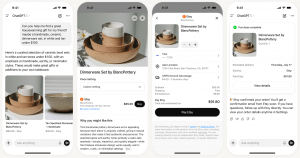ChatGPT Can Now Sell Your Products… But Only If Your Data Is Ready
OpenAI just launched Instant Checkout, a new way for people to buy products directly through ChatGPT. It is powered by the Agentic Commerce Protocol (ACP), an open standard that connects AI agents, merchants, and payment systems to complete transactions securely.
What’s changed?
While it is only available in the US for the time being (live now with Etsy, and Shopify is coming soon) it won’t be long before other merchant providers and eCommerce platforms also support this functionality.
Product results within ChatGPT are exclusively organic. There are no ads or paid boosts, and worth noting being available on Instant Checkout does not mean a given item will gain any traction in search results over items that aren’t: products are ranked solely by relevance to the user. This function works across all desktop and mobile OS, and supports all major cards as well as Google Pay, Apple Pay and Stripe’s Link. Etsy checkouts inside ChatGPT settle in USD, with all payment methods listed clearly. At the moment, Instant Checkout only supports single-item purchases, but plans are under way to enable multi-item baskets alongside the rollout to more platforms and regions.
If you’re a vendor on either Etsy or Shopify, you will be auto‑enrolled. Everyone else needs to build a product feed, enable their Stripe‑based checkout using ACP, and submit a form.

What eCommerce CMOs need to know
ACP changes how shoppers will discover and buy online. Chat is moving from discovery into a direct revenue channel, from an awareness touchpoint to a conversion surface, where intent is captured and converted in a single flow. A shopper can go from “best waterproof trail shoes under £150” to checkout without leaving the platform.
This shift matters because it creates a new form of attribution. Transactions that happen inside ChatGPT can be tracked more cleanly than multi step journeys across web and ads, giving CMOs a clearer view of channel performance.
The competitive edge will not come from keywords but from structured data. CMOs must ensure their teams treat product information as a strategic asset, with consistency across pricing, fulfilment, attributes, and reviews. Incomplete data means missed visibility and lost revenue.
ACP also changes budget considerations. Instead of paying for clicks, you only pay a small fee when a transaction completes. This has the potential to alter how acquisition cost is measured compared to ad-driven platforms.
Adapting our eCommerce SEO strategy
The first instinct will be to map a Google Shopping feed across. That would be a mistake. ACP isn’t a search index, it is closer to a conversational database.
ChatGPT isn’t matching keyword fields. It reasons over structured product data and shopper intent (budget, delivery window, materials, variants, etc.). Your feed becomes the source of truth the model uses to decide relevance. Practically, this means:
- Treat your feed like a conversational database, not an ad feed
- Supply decision-grade attributes: category, materials, weight, sizing system, price, stock, shipping methods, and delivery estimates
- Keep it fresh: OpenAI’s ingestion accepts updates every 15 minutes
Winning in ChatGPT shopping may come down to data density. The most complete and accurate data wins, not the catchiest keywords.
Imagine a shopper asks:
“I need waterproof trail running shoes with good cushion for under £150 that will arrive by Friday.”
The system checks attributes like material, weight, shipping speed, return window, and review count. If your product feed contains those details, you are more likely to appear as the best match.
If this is being driven by AI, and not a simple database/attribute lookup, this could be akin to the Google Gemini functionality we are seeing portrayed on the current series of Samsung phone adverts.
The opportunity
Most brands will not do this. Their product data is incomplete, and they won’t invest in filling optional fields. That attrition creates an opening. The brands willing to do the detailed work gain an informational advantage.
The [description] field, with its 5,000‑character limit, is also a battleground. It becomes the source material for the AI’s answer, and should be packed with rich, contextual detail. Your objective for the description should be:
- Write decision-grade, plain-text descriptions that help ChatGPT answer buyer questions confidently
- Prioritise facts over flair: no keyword stuffing, no HTML
- Keep within your platform’s character limit: aim for ≤4,500 characters to leave headroom
Inputs you should pass within the description (per SKU):
- Identity: product_category, brand, model/name, primary use cases, who it’s for
- Build: materials & composition, construction, dimensions, weight, colour(s), variants, compatibility
- Performance/fit: key capabilities, limits, sizing system, fit guidance
- What’s included: box contents, accessories, etc.
- Care & safety: care instructions, warnings, certifications/standards
- Commercials: price, warranty, return window, country of origin
- Fulfilment: shipping methods/services, regions, delivery estimate logic (don’t make it up), packaging size/weight if relevant
- Social proof: review count / average (only if you can substantiate it)
- Differentiators: what makes it better/different (factual)
Several attributes are required beyond the basics. For example, material, weight and fulfilment signals live under [shipping] and [delivery_estimate].
This is not to forget to also submit updates as often as every 15 minutes to keep price/availability accurate and avoid mismatches.
The future of AI eCommerce
At its core, ACP represents a shift in how e commerce works. AI search is no longer just about discovery, they are becoming about conversion inside AI interfaces.
For CMOs, the priority is clear. Audit your product data, build a process to maintain completeness, and rethink attribution models for a world where conversations are transactions.
Agentic commerce is here, and it is reshaping the future of shopping.